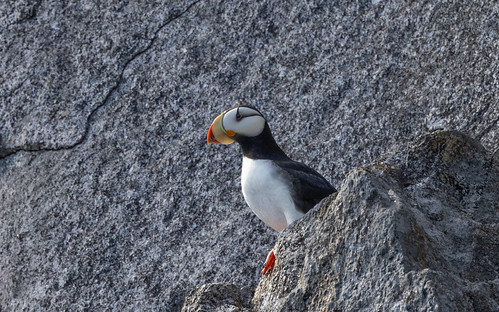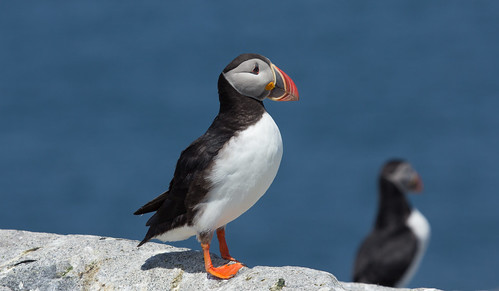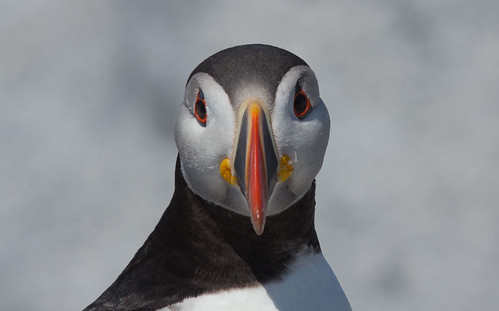When Russ and I were in Alaska, if I’d been limited to seeing and photographing just one species of bird, I’d have picked the Horned Puffin—one of the most treasured birds on my life list yet one of the few that I’d never photographed. Indeed, before this trip I’d seen only one in my life, at the northern end of Alaska’s Inside Passage in 2001. I was also hoping for good Tufted Puffin photos—I’d seen lots of them on that Inside Passage trip, and also on a couple of pelagic boat trips off California and once from a fishing boat out of Newport, Oregon, but had very few photos, hardly any of them good.
Oddly enough, I have over a thousand photos of Atlantic Puffins from boat trips off the Maine coast, including hundreds of excellent close-ups from a couple of hours in an observation blind on Machias Seal Island during my Big Year in 2013.
In all the world, there are only three species of puffins. They belong to the genus Fratercula, a word that comes from Medieval Latin for friar or monk. Some believe the generic name was given because flying puffins draw their feet together as if in prayer, but the predominant theory is that their black-and-white plumage reminded someone of the monastic robes worn by friars. Either way, I find it bewildering that anyone would think of a somber-garbed, celibate monk when naming birds with such extraordinarily jolly and colorful faces who mate right out there in open water and on their colonial nesting grounds in full view of other seabirds and ornithologists. Two common nicknames, the “clown of the sea” and “sea parrot,” could have provided more understandable roots for puffins' genus name.
It’s true that only adults wear this spectacular plumage, and only during the few months of the year that they’re courting and nesting; their faces grow much duskier, they shed the large, colorful plate at the base of the bill, and the bright orange bill tip, legs, and feet grow duller after they leave the breeding islands for the open ocean when their young no longer need them.
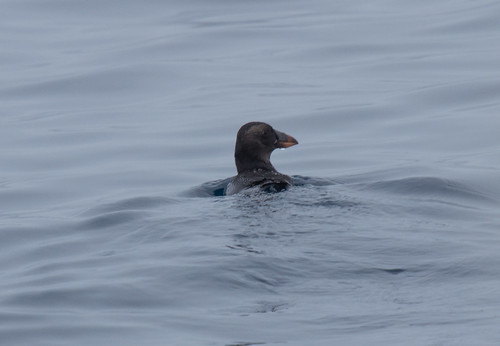 |
| Immature Tufted Puffin. Non-breeding adults are a little brighter, but not much. |
But puffins, especially Atlantic and Horned Puffins, are seldom seen except during that short breeding season. The rest of the year they are too dispersed and too far out at sea for much observation. The people who first named them were much more familiar with breeding than non-breeding adults, so you'd think they'd have chosen something more apt.
I like to pretend that the English word puffin, which sounds like "puffy," reflects the birds’ adorable plumpness, but it has a much more sinister derivation. An unrelated seabird, the Manx Shearwater, holds the scientific name Puffinus puffinus, which comes from Middle English for the delicious, fatty meat of the defenseless nestlings, which for centuries were snatched out of their burrows by the thousands in Ireland, Scotland, the Scottish islands, and the Isle of Man. Puffins were given their vernacular name because their nestlings are equally plump and defenseless. Fortunately, Iceland is the only country in the world where puffins are still legally hunted.
The only puffin found on the Atlantic is, appropriately, called the Atlantic Puffin. The two on the Pacific are the Horned and Tufted Puffins. Some taxonomists believe that Tufted Puffins are more closely related to Rhinoceros Auklets than to the other two puffins.
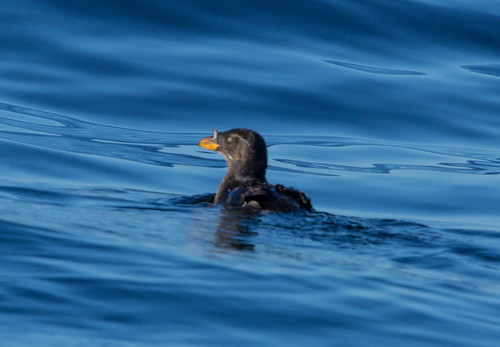 |
| Rhinoceros Auklet |
These ornithologists place Tufted Puffins in a monotypic genus, Lunda, but the American Ornithological Society is still keeping Tufted Puffins in Fratercula.
Audubon painted all three puffins in his Birds of America, but he saw just one species in life, the Atlantic Puffin, during his 1833 journey to Labrador.
He used specimens from Britain’s acclaimed ornithologist John Gould to paint his Horned Puffins in 1834 or 1835.
He wrote of his Tufted Puffin painting that a hunter had shot his specimen at the mouth of the Kennebec River in Maine in the winter of 1831-32.
Scientists have long questioned the accuracy of that claim, but this year a Tufted Puffin turned up in a few spots in Maine, making Audubon’s account more believable.
